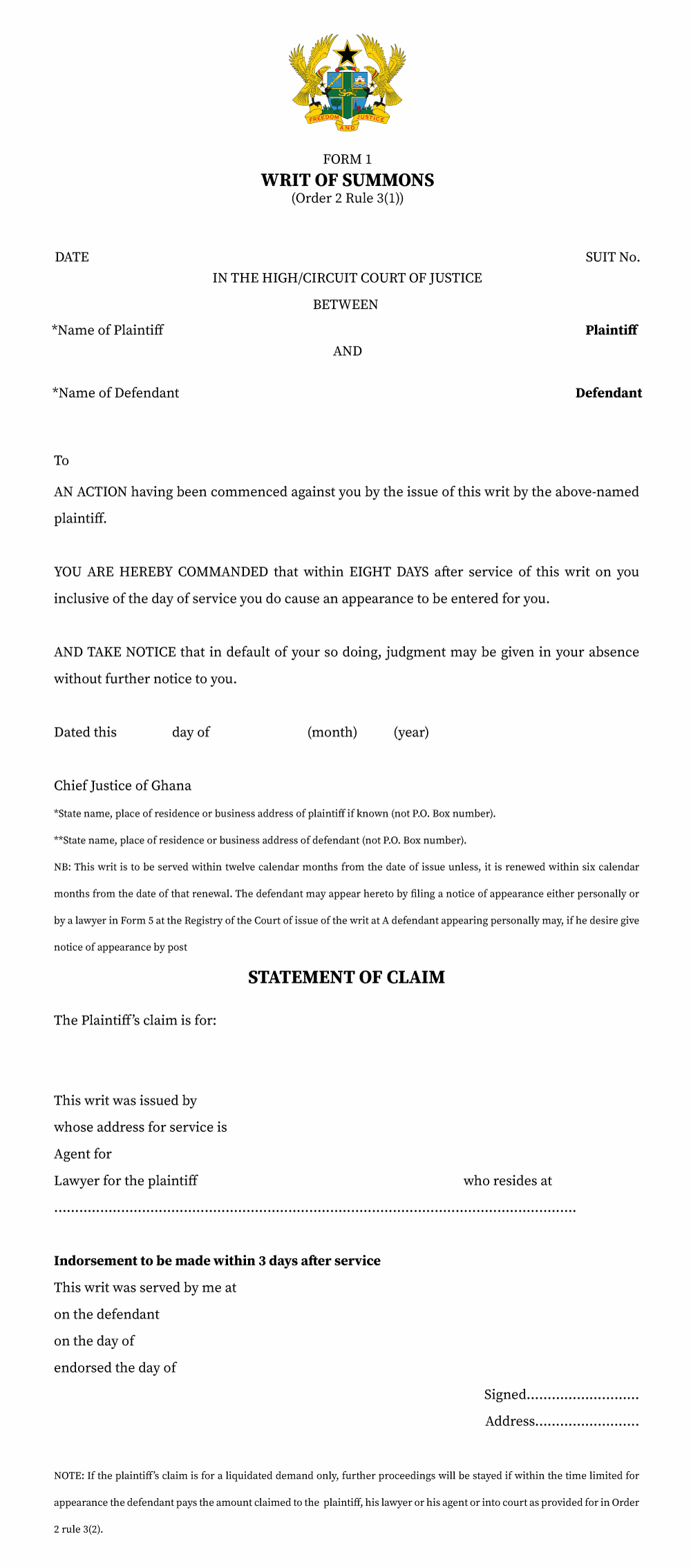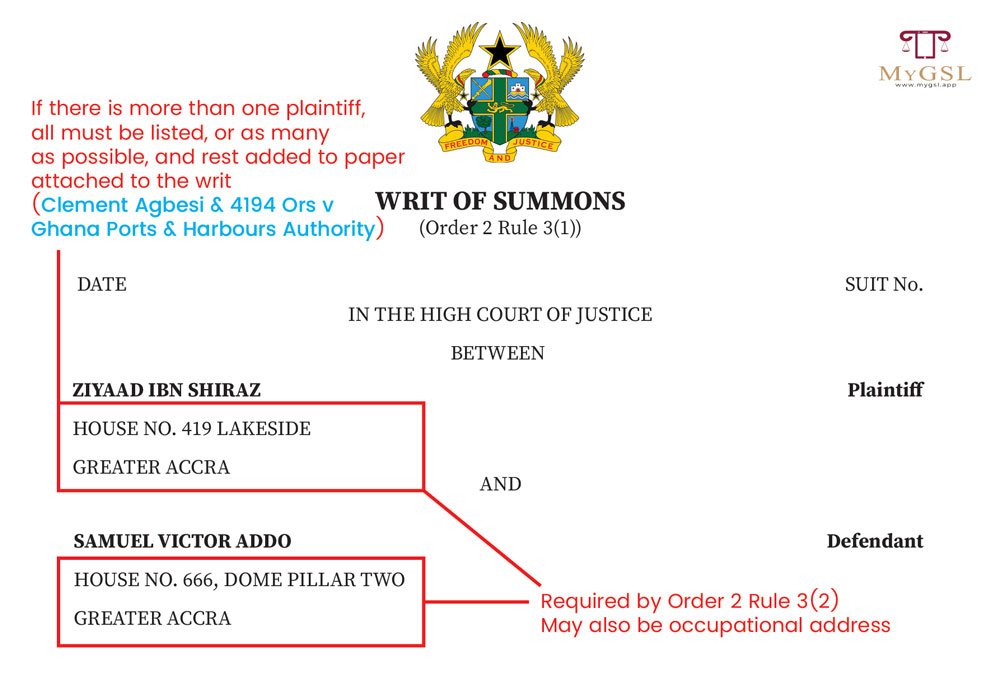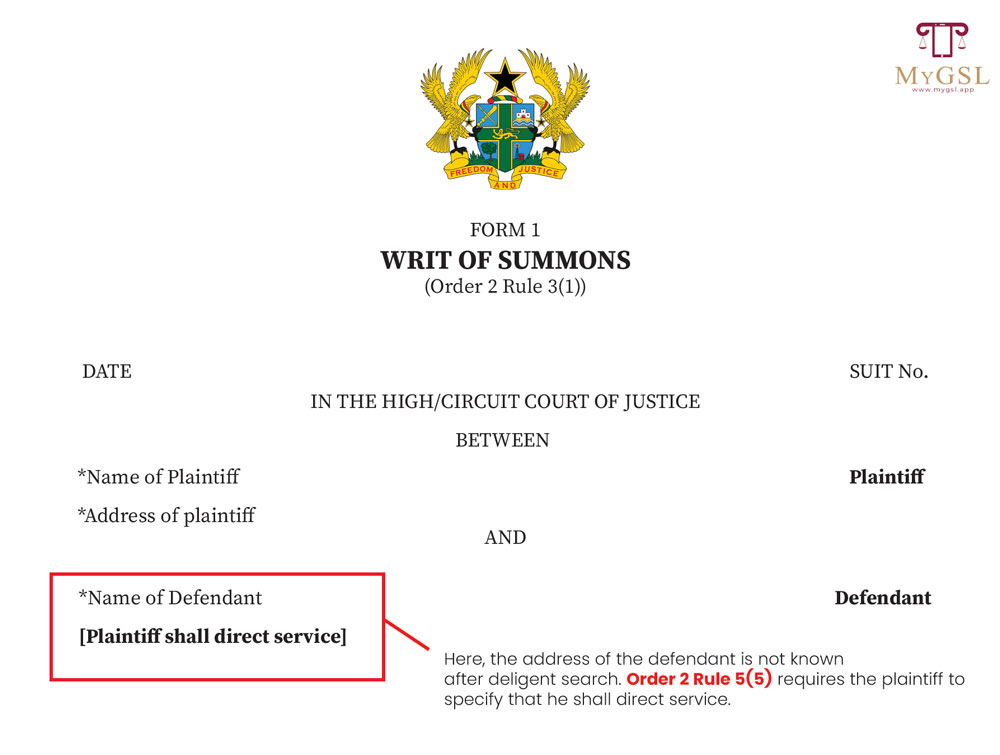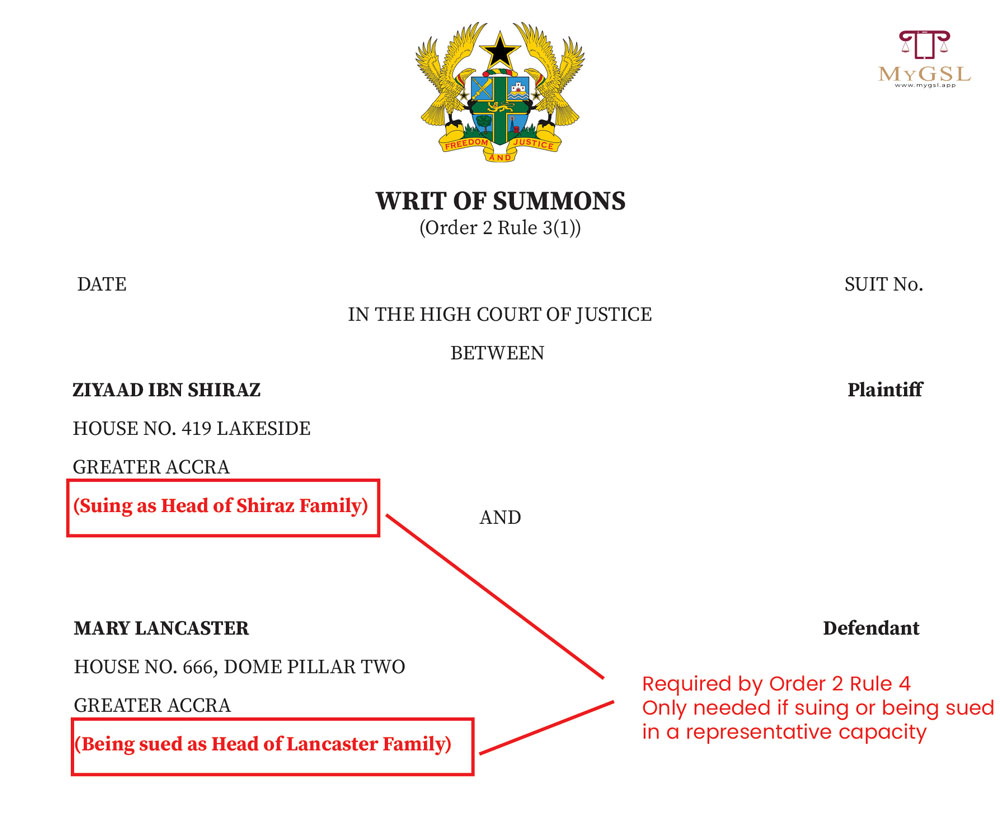Note on Contents of a Writ of Summons by Legum
Contents of a Writ of Summons
Introduction:
In a previous note, we discussed the meaning of a writ of summons, its general use as the principal means of commencing civil proceedings, and the factors to consider before commencing a civil proceeding via a writ of summons.
In this note, we will discuss the contents of a writ of summons. We will examine the name of the court in which the action is being commenced, the names and addresses of the parties, the indorsement as to capacity, the command, the address for service of the plaintiff, endorsement with a statement of the nature of the claim, relief or remedy sought, and a statement on stay of proceedings if a liquidated demand is paid.
General Provision on the Content of a Writ of Summons:
In Order 2 Rule 3 (1) of the High Court (Civil Procedure) Rules, 2004 (C.I. 47) , it is provided that:
Every writ shall be as in Form 1 in the Schedule and shall be endorsed with a statement of the nature of the claim, relief or remedy sought in the action [emphasis added.]
In Form 1, a sample writ of summons is provided. It may, thus, be said that generally, every writ of summons must have contents similar to Form 1 and similarly structured. Below is an illustration of the writ of summons in Form 1:

Contents of a Writ of Summons:
The discussion in this section is shaped by the provisions of Order 2 of C.I. 47 and the content of the writ of summons in Form 1.
Content 1: Name of the Court in Which the Party Intends to Commence his Action:
In the writ of summons in form 1, there is the phrase “IN THE HIGH/CIRCUIT COURT OF JUSTICE.” It is up to the party to decide if he is suing in the High Court or in the Circuit Court. If he is suing in the High Court, the practice is that he specifies the division of the High Court such as Land Division, Divorce and Matrimonial Division, Probate and Administration Division, Labour Division, Human Rights Division, Commercial Division, Financial Division, General Jurisdiction, among others.
Content 2: Names, Residential and Occupational Addresses of the Parties:
A. General Provisions:
On the face of the writ, the plaintiff must state his first and last names correctly and state those of the defendant.
In addition, as required by Order 2 Rule 3(2) of C.I. 47 , the occupational and residential address of the parties (both plaintiff and defendant) shall be stated on the writ. If Ziyaad wants to institute an action against Sam in the High Court for damages for breach of contract, the name and address section of the writ will be as follows:

B. When Address for Defendant is not Known after Diligent Search:
While the address of the plaintiff is often known, that of the defendant may not always be known. In such cases, Order 2 Rule 5(5) of C.I. 47 provides that “Where the address of the defendant after diligent search is not known, the plaintiff shall indicate on the writ that the plaintiff shall direct service.”

C. Where there are Multiple Plaintiffs:
A suit may be commenced by just one person who has a claim, or by thousands of persons who have identical claims. If multiple persons are issuing a writ, they are all considered plaintiffs, and there is a requirement that all their names and addresses appear on the writ of summons.
In the case of Clement Agbesi & 4194 Ors v Ghana Ports & Harbours Authority Civil Appeal No. J4/20/2007 , the Supreme Court of Ghana held that persons whose names did not appear on the writ cannot be considered parties to it, even if they were envisioned to form part of “others”. In that case, their lordships of the Supreme Court opined that:
…the title of a writ of summons must have the name/s of all plaintiff(s) or as many as it can contain on its face, or on a piece of paper attached to the writ (if the writ cannot contain all the names). It was after this that the heading of subsequent processes can be headed the plaintiffs “and others.
They proceeded to provide the following reason for why all the names of the plaintiffs must either be on the writ or on a paper attached to it:
It was of a vital importance the identity and number of the parties in any suit was known at any given stage of the proceedings. The real necessity to do so was for the plaintiffs or defendant to know who their adversaries were so that they could raise issues of estoppel and mount real defences, etc, against each other should it become necessary so to do, at any stage of the proceedings or in the future, or for the plaintiffs’ claim/s or defendant’s liability/ies fought on the merits. It would also make service of court processes easier, for the parties would know who to serve with any process. In this case the question is how were the “others” in the writ served with any of the processes filed by the defendant?
Where it becomes necessary to supplement the list of plaintiffs, this should be with the leave of court for in this case the full list was provided after the statement of defence and reply had been filed. In fact summons for directions had been filed on 20-11- 03 and under the rules of court pleadings had closed. At that stage a party could only amend with the leave of court. Apparently, no leave had been applied for or granted for the filing of the full list of 3839 persons as plaintiffs. The majority opinion on the point was more correct than that of the minority.
...
We agree with the reasons and affirm the majority decision/opinion that under the circumstances, “the 3839 names were total strangers to the writ”. The contrary decision by the minority on this issue is rejected as being an error.
Summarily, a person whose name does not appear on the writ as a plaintiff or a defendant cannot be considered party to the suit, unless there is due amendment of the writ.
Content 3: Indorsement as to Capacity:
A. Meaning of Indorsement as to Capacity:
A close reading of Order 2 Rule 4 of C.I. 47 reveals that “indorsement as to capacity” is simply a statement of the capacity in which a person sues, is sued, or acts. A person may sue on his own behalf, on behalf of his family or a disabled person (persons less than 18 or of unsound mind), as an administrator or executor of an estate, among others. This was acknowledged by Atuguba JSC in the case of Larkai v Tetteh [2009] SCGLR 621 when he said:
It is trite law that a person can sue in several capacities, see Akrong v. Bulley (1965) GLR 496 S.C.
In said Akrong and Another v. Bulley [1965] GLR 469 referred to by his lordship, one Bulley died as a result of wounds sustained from an accident caused by the first defendant-appellant. His mother issued a writ claiming damages under the Fatal Accidents Acts, 1846-64. The writ revealed that she was suing in her capacity as successor and next-of-kin. Under the Fatal Accidents Acts, 1846-64, it was only the personal representative or dependant of a deceased victim that had the capacity to sue for damages. However, at the time of issuing the writ, the plaintiff was not the personal representative, as letters of administration had not been obtained. When the capacity of the plaintiff was challenged, she contended that she was suing in the following multiple capacities:
1. Successor
2. Next of kin
3. Dependant
4. Personal representative.
She added that if the Fatal Accidents Act recognised a dependant as having capacity, the other capacities could be disregarded as mere surplusage. This argument was dismissed, as the writ did not state that the plaintiff was suing in her capacity as a dependant.
Summarily, indorsing as to capacity simply means to make a statement on the capacity in which one issues a writ or commences an action.
B. Purpose of Indorsement:
The capacity of a party determines whether the party can commence an action, defend an action, or be entitled to a remedy even where the party can commence or defend the action. In the case of Akrong and Another v. Bulley (supra) for instance, the plaintiff commenced the action in her capacity as successor and next of kin. However, under the Fatal Accidents Act, a successor or next of kin did not have the capacity to claim damages under the Act. This led the Supreme Court to declare that the writ and all proceedings and judgement obtained under it were a nullity. The ruling in this case was upheld by the Supreme Court in the more recent case of Republic v. High Court, Accra; Ex Parte Aryeetey [2003-2005] 1 GLR 537 , where their lordships delivered themselves as follows:
The requirement that a party indorses on the writ the capacity in which he sues, is to ensure that a person suing in a representative capacity is actually invested with that capacity and therefore has the legal right to sue . This includes the submission that the requirement also enables a defendant, if he is so minded, to challenge the capacity the plaintiff claims he has, and such a challenge may be taken as a preliminary issue. This is because if a party brings an action in a capacity he does not have, the writ is a nullity and so are the proceedings and judgment founded on it. Any challenge to capacity therefore puts the validity of the writ in issue . It is a proposition familiar to all lawyers that the question of capacity, like the plea of limitation, is not concerned with merits so that if the axe falls, then a defendant who is lucky enough to have the advantage of the unimpeachable defence of lack of capacity in his opponent, is entitled to insist upon his rights: see the case of Akrong v Bulley [1965] GLR 469, SC.
Summarily, indorsement as to capacity can determine the validity of a writ.
C. Consequence of Failing to Indorse a Writ as to Capacity:
If a person sues in a representative capacity or sues another in a representative capacity, but fails to indorse the writ as to capacity, he risks the action being thrown out. In the case of Living Faith World Outreach Centre & 2 Ors v. The Registrar-general &4 Ors [2023] GHASC 27 (17 May 2023) , the Supreme Court of Ghana stated that:
If a Plaintiff, in fact, sues in a representative capacity but fails to indorse that fact on his writ of summons and his capacity is, as a result, challenged at the trial, then the whole action risks being thrown out by the court if the Plaintiff is unable to prove his capacity after the challenge.
Sometimes, a wrongful indorsement may also lead to the action being thrown out. For instance, in Akrong and Another v. Bulley (supra) , the writ was indorsed as to capacity because the plaintiff stated that she was suing as successor and next of kin. However, a successor and next of kin did not have the capacity to claim damages under the Fatal Accidents Act. This led to the writ being declared a nullity.
D. Circumstances where a Plaintiff must Indorse as to Capacity:
Per Order 2 Rule 4 of C.I. 47, a plaintiff must indorse as to capacity in the following three circumstances:
1. The plaintiff is suing in a representative capacity. Here, there should be indorsement with the representative capacity in which the plaintiff sues.
2. The defendant(s) being sued, is sued in a representative capacity. Here, there should be indorsement with the representative capacity in which the defendant is sued.
3. If the plaintiff is acting on behalf of a person resident outside Ghana, there must be a statement of that fact and the address of the person outside Ghana. In the case of Naos Holdings Inc. Versus Ghana Commercial Bank (2005-2006) SCGLR 407 , an action was commenced on behalf of a person resident outside the jurisdiction, and her residential address was not stated. The Supreme Court held that “the writ was void for failure to state the residence of the plaintiff in the action.”
It should be noted that, generally, where a plaintiff sues in a personal capacity, there is no need to indorse the writ as to capacity. In the case of Living Faith World Outreach Centre & 2 Ors v. The Registrar-general &4 Ors (supra) , the Supreme Court, in commenting on the effect of Order 2 Rule 4 of C.I. 47 , said:
From the above rule, it is only where an action is brought in a representative capacity, that a Plaintiff is required to indorse that fact on his writ of summons...There is therefore no general requirement for a Plaintiff to indorse his capacity whenever a writ is filed. The rule therefore presumes that an action is filed in a Plaintiff’s personal capacity where it is not indorsed that he sues in a representative capacity
E. Placement of Indorsement as to Capacity:
In Order 2 Rule 4(1) of C.I. 47, it is only stated that “before a writ is filed it shall be indorsed…” The rule makes no mention of where the statement of capacity must appear (whether on the writ of summons or statement of claim).
The accepted position is that indorsement as to capacity should be on the writ of summons, thus on Form 1. This often appears below the address of the parties.
In the case of Living Faith World Outreach Centre & 2 Ors v. The Registrar-general &4 Ors [2023] (supra) , the Supreme Court stated that when a plaintiff is suing in a representative capacity, and by extension, when a defendant is being sued in a representative capacity, the plaintiff is “required to indorse that fact on his writ of summons [which is in Form 1 in C.I. 47] .” In that case, the 3 rd to 8 th plaintiffs did not indorse their capacity on the writ of summons but did so on the statement of claim. Their lordships considered this a defect, but held that since a writ is defined to include a writ of summons and a statement of claim under Order 82 Rule 3 of C.I. 47,
[The] defects in a writ are presumed to be cured by the statement of claim since the two are seen as one. See Unilever Ghana Ltd. vs. Kama Health Services Ltd. [2013-2014] 2 SCGLR 861 and Opoku & Others (No.2) vs. Axes Co. Ltd. (No.2) [2012] 2 SCGLR 1214 ;
In spite of this holding, it is safer to place the indorsement as to capacity on the writ of summons. This is often done beneath the address of the plaintiff if he is suing in a representative capacity, and beneath the address of the defendant if he is being sued in a representative capacity. Below is a sample:

Content 4: The Command:
A key part of the writ of summons is the command given to the defendant to cause an appearance to be entered for him within eight days after service of the writ on him, inclusive of the day of service.
The defendant is further notified that if he fails to cause an appearance to be entered for him, judgement may be given in his absence without further notice to him.
Content 5: Address for Service of the Plaintiff:
A. Meaning of Address for Service of the Plaintiff:
After the plaintiff issues a writ and the writ is served on the defendant, the defendant often files entry of appearance and a statement of defence. By filing entry of appearance, the defendant is simply acknowledging receipt of the writ. By filing a statement of defence, the defendant is simply responding to the claims of the plaintiff, and providing contrary arguments, facts, among others. These documents will need to be sent to the plaintiff, either directly or through his lawyer, and the address to which they are sent is the “address for service of the plaintiff.”
B. What is the Actual Address for Service of the Plaintiff?
In Order 2 Rule 5(1), and before filing the writ, the plaintiff is required to indorse the writ with an address of a place in the country to which documents for him may be served. Depending on whether he is suing in person or by a lawyer, he is required to indorse on the writ any of the following:
1. His occupational and residential addresses if he sues in person (e.g. a lawyer or non-lawyer suing another person, and representing himself in court).
2. If he, however, sues by a lawyer:
a. his residential and occupational addresses
b. the lawyer’s firm name and business address.
The addresses in bullet point 1 or those in bullet point 2 are the addresses for service [per Order 2 Rule 5(2)], depending on whether the plaintiff sues in person or by his lawyer.
If the plaintiff sues by his lawyer, the address for service of the lawyer is provided at the back of the Writ. In Form 1 of C.I. 47, a place has been provided for the lawyer’s address for service. Here is a sample:

Content 6: Endorsement of the Writ with a Statement of the Nature of Claim:
Order 2 Rule 3(1) of C.I. 47 provides that the writ “shall be endorsed with a statement of the
nature of the claim, relief or remedy sought in the action.” In an attempt to enable a plaintiff fulfil this requirement, form 1 of C.I. 47 contains a section headed “Statement of Claim.” It is crucial to understand that this section is the section for the plaintiff to state the nature of his claim or relief sought pursuant to Order 4 Rule 3(1) (supra) , and is often called the endorsement section. In an action for a declaration that an act or omission is unconstitutional, for instance, this section will contain statements like:
1. A declaration that [Act being challenged] is inconsistent with [Article being referenced] of the 1992 Constitution and therefore null and void.
2. An order directed at [Person or Authority] to [action to be performed].
3. Any other order(s) that this Honourable Court may deem fit to make.
Also, it is crucial to note that the “Statement of Claim” contained in Form 1 is not the statement of claim referred to in Order 2 Rule 6 of C.I. 47 which must accompany the writ of summons.
Content 7: Statement on Stay of Proceedings if Liquidated Demand is Paid:
In Order 2 Rule 3(3) of C.I. 47, it is provided that:
Where the plaintiff's claim is for a liquidated demand only, the writ shall include in addition to the amount claimed in respect of the demand a statement that further proceedings will be stayed if within the time limited for appearance the defendant pays the amount claimed.
A liquidated demand is a demand for a fixed sum of money, say Ghc 100. If a plaintiff institutes an action and his endorsement of the relief sought reveals that he is demanding payment of a fixed sum of money from the defendant, Order 2 Rule 3(3) of C.I. 47 requires him to add a statement that he will stay proceedings if the amount is paid within the time limited for appearance (8 days).
This statement has already been provided in Form 1 of C.I. 47 and reads:
NOTE: If the plaintiff’s claim is for a liquidated demand only, further proceedings will be stayed if within the time limited for appearance the defendant pays the amount claimed to the plaintiff, his lawyer or his agent or into court as provided for in Order 2 rule 3(2).
Conclusion
We discussed the various sections of a writ of summons as outlined in Form 1 of C.I. 47. First, we explained that a writ of summons must contain the name of the court in which the action is being initiated, which may either be the High Court or the Circuit Court. Second, we stated that the names and addresses of all the parties must be included in the writ of summons. We also addressed edge cases, such as when a defendant’s address is unknown or when there are multiple plaintiffs. Next, we noted that when a person sues in a representative capacity, they must indicate this capacity on the writ. We also emphasized that the writ must include the address for service of the plaintiff, which can either be the plaintiff's address or the business address of their lawyer. Additionally, we discussed that a writ must be endorsed with a statement describing the nature of the claim or the relief sought. Finally, we highlighted that if the claim involves a fixed sum of money, the writ should include a statement indicating that further proceedings will be stayed if the specified amount is paid within eight days after the issuance of the writ.
Speed
1x